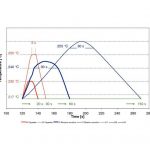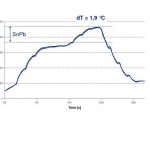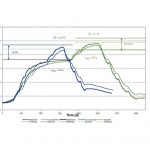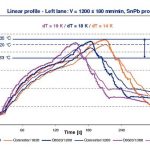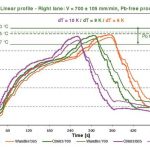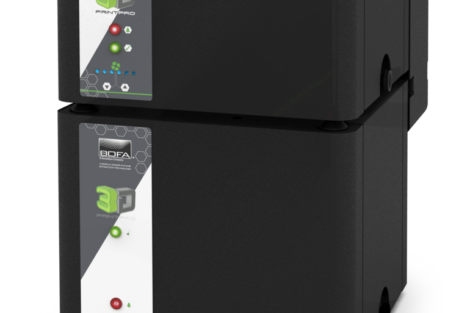Bans on the use of substances set forth by RoHS have become daily routine in manufacturing facilities around the world. A few temporary exceptions to the ban on lead are forcing many electronics manufacturers to work with tin-lead as well as lead-free solders. The separate SMD production lines required to this end, or continuous changing of process parameters to match the respective solder at a single production line, increase manufacturing costs.
Dr. Hans Bell, Rehm Thermal Systems, Blaubeuren
Implementing both processes simultaneously with a single reflow soldering system is a very inexpensive alternative. From a technical standpoint, this task can be approached in two different ways:
- 1. Two thermal systems are set up next to each other within one basic system; i.e. in addition to the conveyor lanes, there are two separately controllable heating systems for reflow profiling. Stated briefly, this involves the use of two ovens in one. This, of course, makes the system more expensive.
- 2. Different reflow profiles are set up next to each other within a single thermal system for two conveyor lanes. This is accomplished by taking advantage of the thermodynamic characteristics of the heat transfer system. The advantage: In this case, investment costs are only increased by the amount required for a two-lane conveyor system.
Rehm has decided in favor of this approach.
Thermodynamic Characteristics
Heat transfer between a reflow system and the PCB to be soldered is generally described by means of the following equation:
q = a · t · A · ΔT
a – Heat transfer coefficient [W/m²K]
t – Time [s]
A – Surface area [m²]
ΔT – Temperature difference [K]
The amount of time specified in the equation is determined by the speed at which the PCBs move through the system. And thus differing conveyor speeds with constant temperature differences (oven zone temperature minus PCB temperature) must result in different amounts of heat flow within the PCB. In other words, changing the conveyor speed inevitably alters the temperature profile for the PCB. As conveyor speed is reduced (i.e. longer dwell time in the oven), all reflow times (preheating time, time above liquidus and cooling time) increase, maximum temperatures rise and the difference in temperature between small and large thermal masses on the PCB is increased.
It becomes apparent that conveyor speed has an immensely complex influence on the reflow profile, and the following question is thus elicited: “Can SnPb and lead-free (SAC) soldering processes be implemented in the same temperature zones simply by using two different conveyor speeds?”
In order to answer this question adequately, the working windows for both processes must first be defined. Taking a look at IC standards JEDEC J-STD-020D.1 and J-STD-075 is helpful to this end, which define maximum reflow temperatures (maximum process temperature TP < classification temperature TC) for the respective component types and classes. The lower limits of the process window can be derived from general experience with necessary overheating above the liquidus temperature of the respective solder for the production of reliable solder joints.
Of course the definition of the process window must always be based on the “weakest link”, namely the component with least amount of thermal stability during the soldering process. Maximum process temperatures for large and small electrolytic capacitors are depicted next to those for moisture-sensitive components with large and small packages. The graph demonstrates that electrolytic capacitors can often only be processed by accepting certain compromises.
If two different processes are to be set up next to each other in the same reflow system, and if thermally sensitive components are included on the PCB, great flexibility is required for parameters configuration.
The technical layout of the Dual Lane VX reflow soldering system allows for highly flexible process setups, and thus opens up a wide process window for soldering. The Dual Lane version of the VX is equipped with two conveyor lanes which can be operated asynchronously at different speeds. With the multi-track variant, the two lanes can also be operated asymmetrically with different lane widths.
Heat zones which are thermally well isolated from each other, and which are arranged in a 350 mm grid pattern both above and underneath the conveyor lanes over the entire length of the process chamber allow for greatly varying reflow profiles. A single homogenous heat zone, with just a single fan, spans the width of the process chamber and both conveyor lanes at each respective location. There are no thermal barriers (gas deflector plates) or divided nozzle sheets between the conveyor lanes which would individually influence the flow of gas for the left and right-hand sides. The temperature of the gas and the speed at which it flows is thus identical for both lanes.
If the two lanes of the Dual Lane VX are simultaneously loaded with lead-containing and lead-free PCBs, respectively optimized reflow profiles can only be achieved by means of different conveyor speeds. The VX offers ideal prospects for this purpose.
SnPb and Lead-Free Reflow Profiles
Minimal temperature differences of less than 2 K within the transverse profile for the respective lane contribute to assuring the largest possible process window. As the result of various measurements, it has been substantiated that SnPb and lead-free PCBs can be processed next to each other at the same time in the Dual Lane VX. During the course of these measuring campaigns (which made use of various boards), two identical test PCBs were run through the reflow system at different speeds in the right and left lanes. The results were then discussed.
SnPb reflow profiles for large and small thermal masses on the PCBs are always shown on the left-hand side of the graphs, and the lead-free profiles (SAC) are shown on the right-hand side. The horizontal lines delineate the working windows:
SnPb process: 183 … 220 … 235° C
SAC process: 217 … 245 … 260° C
The dashed temperature lines (220 and 245° C) indentify maximum temperature for the more thermally sensitive components. The reflow profile is always represented with the thinner line width for the measuring campaigns.
Looking at two simultaneously produced linear reflow profiles for an automotive board: Due to the higher conveyor speed, delta T (dT) between the large and small thermal masses on the PCB is larger for the SnPb process than for the SAC process. Longer dwell times allow for better temperature equalization on the PCB. Nevertheless, process window limits are not violated with the SnPb profile either, and fully acceptable reflow profile values are achieved. Small as well as large thermal masses are significantly below the permissible maximum temperatures. Ideal times above liquidus (approx. 60 seconds) are achieved with both processes. Saddle-shaped reflow profiles can also be used in parallel processes. In order to substantiate how robustly the parallel processes can be run with a VX, measurements were performed with a PCB using a tolerance range of ±15 % for conveyor speed, with continuously identical temperature settings. As conveyor speed is reduced, maximum temperature and time above liquidus are increased, and the temperature difference (dT) between large and small thermal masses is decreased. Within the stipulated tolerance range of ±15 % for a conveyor speed of 1200 mm per minute for the SnPb process and 700 mm per minute for the lead-free process, the resulting reflow parameters remain within the specified limits. Similarly good results have also been obtained for the saddle profiles. And thus it has been possible to demonstrate that an adequately large working window for parameters configuration is assured.
Summary
SnPb and lead-free PCBs can be soldered simultaneously with the Dual Lane VX reflow soldering system. The different reflow profiles required to this end are achieved solely through the use of different conveyor speeds for the two parallel lanes. The temperature settings for the heating and cooling modules are identical, because the modules span both conveyor lanes in a homogenous fashion. Nor are there any additional technical fixtures, for example separate nozzle sheets or gas deflector plates, which would be able to influence heat transfer at the two sides of the system. On the one hand this increases ease of use for the operator, and on the other hand investment costs are kept down to same level as required for a series produced Dual Lane VX system. Extensive measurements have confirmed that the specified working windows for the SnPb and lead-free processes are strictly adhered to, and that an adequate working range for configuring system settings, especially conveyor speed, is provided.
EPPE 444
zusammenfassung
Mehr und mehr Unternehmen sehen sich der Tatsache gegenüber, dass sowohl bleifrei als auch mit Blei gelötet werden muss. Als eine preisgünstige Alternative bietet es sich hier an, beide Prozesse gleichzeitig auf einem einzigen Relow-Lötsystem zu implementieren.
De plus en plus d’entreprises doivent être prêtes à effectuer des brasages sans plomb, mais aussi avec. Pour celles-ci, la mise en œuvre des deux processus simultanément via un seul système de brasage par refusion se présente comme une alternative économique.
Share:




